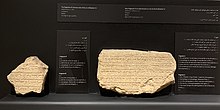
The Son of Safatba'al inscription is a Phoenician inscription (KAI 9) dated to c. 500-475 BCE.
It was published in Maurice Dunand's Fouilles de Byblos (volume I, 1926–1932, numbers 1143, plate XXXIII).
It is currently at the National Museum of Beirut.
Text of the inscription
Three parts of the inscription are extant. The largest, fragment A (six lines), reads:
(A1a)N
ŠPṬB‘L
MLK
GBL
N ŠPṬB‘L MLK GBL
n of Safatbaal, King of Byblos,
(A1b)P‘LT
LY
HMŠKB
ZN
[...
P‘LT LY HMŠKB ZN [...
I made for myself this resting-place (tomb) [...
(A2a)...]BYTK
BL
T
’RN
‘LT
’RN
...]BYTK BL T ’RN ‘LT ’RN
...] your tomb (?). You shall not per coffin upon coffin.
(A2b)‘L
KN
P‘L[T
LY
HMŠKB
ZN
...
‘L KN P‘L[T LY HMŠKB ZN ...
For this reason have I mad[e for myself this resting-place ...
(A3a)...
WP‘L
’NK
’RN
ZN
L]Y
BMŠKB
ZN
’Š
’NK
ŠKB
BN
... WP‘L ’NK ’RN ZN L]Y BMŠKB ZN ’Š ’NK ŠKB BN
... and I made this coffin for mys]elf in this resting-place that I (am) lying in.
(A3b)WBMQM
place [...
(A4)...]LY
’NTY
BRBM
WYTN
’NK
’LY ’NTY BRBM WYTN ’NK ’ for myself I among the generals. And I gave [...
(A5)...
’L
TPT]Ḥ
‘
ZN
LRGZ
‘ṢMY
’Ḥ ‘ ZN LRGZ ‘ṢMY ’n this to disturb my bones. [...
(A6)...(?)ŠM]Š
‘LŠ ‘Lrnal Se[mes (Sun-goddess) (?) ...

Two smaller fragments, B and C, have been joined together and are now known as fragment B. It reads:
(B1)...]HH[...
...
(B2)...
’L
TP‘L
LK
MŠK]B
’ṢL
HMŠKB ’ṢL HMŠKce (tomb) adjacent to resting-pla[ce! ...
(B3)...]QR
HMŠKB
’Š
TPQR HMŠKB ’Š TPQR(?) the resting-place that you op[en ...
(B4)...
’L
YŠT
’Y]T
’RNW
‘LT
’RN
’NT ’RNW ‘LT ’RN ’N his coffin upon a coffin. I[...
(B5)...
B‘LŠM]M
WB‘L
’DR
WB‘LT
WKL
’M WB‘L ’DR WB‘LT WKL ’m and Baal ’Iddīr and Baalat and all the god[s of Byblos ...
(B6)...]B‘LT
WKL
B‘LT WKL Baalat and all the [gods ...
Bibliography
- Christopher Rollston, "The Dating of the Early Royal Byblian Phoenician Inscriptions: A Response to Benjamin Sass." MAARAV 15 (2008): 57–93.
- Benjamin Mazar, The Phoenician Inscriptions from Byblos and the Evolution of the Phoenician-Hebrew Alphabet, in The Early Biblical Period: Historical Studies (S. Ahituv and B. A. Levine, eds., Jerusalem: IES, 1986 ): 231–247.
- William F. Albright, The Phoenician Inscriptions of the Tenth Century B.C. from Byblus, JAOS 67 (1947): 153–154.
References
- Dunand, Maurice (1939). Fouilles de Byblos: Tome 1er, 1926-1932 [The Byblos excavations, Tome 1, 1926–1932]. Bibliothèque archéologique et historique (in French). Vol. 24. Paris: Librarie Orientaliste Paul Geuthner. and Dunand, Maurice (1937). Fouilles de Byblos, Tome 1er, 1926–1932 (Atlas) [The Byblos excavations, Tome 1, 1926–1932 (Atlas)]. Bibliothèque archéologique et historique (in French). Vol. 24. Paris: Librarie Orientaliste Paul Geuthner – via Bibliothèque nationale de France.
- Donner, Herbert; Rölig, Wolfgang (2002). Kanaanäische und aramäische Inschriften (5 ed.). Wiesbaden: Harrassowitz. p. I, 2.
- Krahmalkov, Charles R. (2000). Phoenician-Punic Dictionary. Leuven: Peeters / Departement Oosterse Studies. ISBN 90-429-0770-3.
- Possibly Urimilk II.
- Ba‘al ’Iddīr or ’Addīr: Powerful, Great, or Mighty Baal.